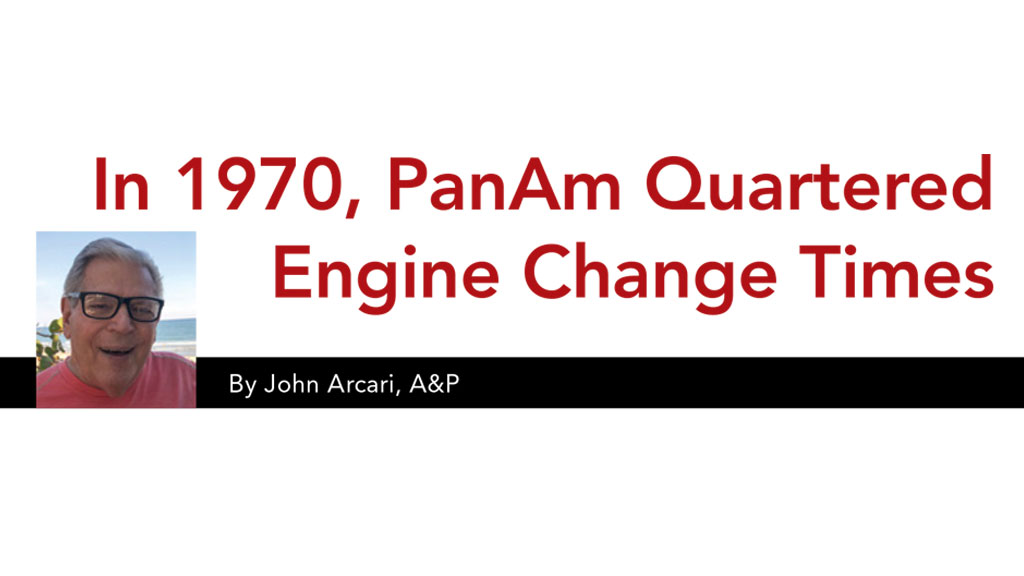In June of 1958, I graduated from Manhattan High School of Aviation Trades with honors. In July of 1958, at 17 years old, I got hired by Pan American World Airways as a temporary aircraft cleaner. Pan Am was not hiring any aircraft mechanics then. I was given a commitment to work through Labor Day in September. When Labor Day rolled around, the employment office at Pan Am advised me, that if I so desired, I could remain on their payroll as an aircraft cleaner. I accepted their offer. In October of 1958, the employment office summoned me and informed me that I had been upgraded to a mechanic helper as a result of my good performance and because I held an FAA A&P Mechanic certificate, earned in high school. And so began my almost thirty-year career at Pan Am.

In the summer/fall of 1969, the new Pan Am aircraft, the B747-100 was being built and then test flown in Everett, Washington. The 747 was headed for commercial airline service, beginning in January 1970. I had been chosen to be part of the Pan Am Maintenance Team that would introduce the B747-100 into commercial flying service. I specialized in two areas, the fuel system and engine replacement. I wrapped my curious brain around both these areas as best I could. By this time, eleven years after starting, I had tons of experience changing engines on numerous types of aircraft and could do an engine change in my sleep.
January 1970 arrived and the first Pan Am B747-100 departed its gate loaded with passengers and cargo for its first commercial flight from JFK to London, England. On taxi, the wind blew up into the #2 engine tailpipe. The engine stalled and we had an engine with metal debris in the exhaust tailpipe. So now, an engine change was required. The aircraft went back to the departure gate and then to the maintenance hangar. My boss, Ron Marasco, called me at home, in the evening, and says, “Johnnie, you best get in here now…we’ve got a problem.” That was the start of literally years of engine changes due to engine casing ovalization (where the engine case became slightly oval causing turbine blades to rub against the engine casing) at high engine power and high EGT temps. This caused compressor stalls due to airflow problems between the compressors and turbines.
It took us about ten to twelve hours to replace the first engine, perform the engine run-up check and get the airplane ready for further service. The aircraft flew the JFK-LHR leg the next evening successfully.
This ongoing engine problems caused a major shortage of engines for many years, but we maintenance folks certainly could not live with ten or twelve hour engine changes…it would ruin our flying operation schedule, and prevent us from a viable business plan.
Now for the good news. Our dedicated, determined, inventive, Pan Am mechanics came through with smarts and innovation. I loved the Pan Am teams at JFK Maintenance. They consisted of WWII, Korean and Vietnam war veterans, and tons of diverse folks. Amazingly, the cultures mixed and blended smoothly together. We hung together, ate together, cried together, laughed together swore together, and yes, sometimes we even fought together. But most importantly, we all worked in unison to take on this massive challenge.
Aircraft mechanics in general are a breed of human being that tries to figure out ways of doing things easier and faster while still remaining safe, professional, efficient and productive. They are always on a quest to do things faster, better and safer. I can tell you, we all realized that safety on the ground and in flight is number one…period. These guys and gals plied their magic and mojo of change and the next thing you know, we were changing B747-100 engines in two to three hours.
We had terrific flight ops crews. Our airmen closely monitored engine performance. We devised a system of identifying engines that were beginning to fail (high EGT). The aircraft would be scheduled back to a main maintenance base to have its engine changed, rather than having an occurrence at an out station. We “borrowed” good engines from aircraft undergoing heavy checks. We made up logistic support kits, with the help of our great material and logistics folks, so they would be ready for use immediately, where and when needed. The ground support equipment to perform the engine changes would be lined up and waiting, as required. An engine change was something to see and admire from start to finish. We kept up our banter, jokes, digs and foul mouths (on occasion) as we debated this or that. At the end of the day, we were a band of loving sisters and brothers, doing our thing, successfully and safely.
Domestic and international airlines at JFK came to us for their engine changes as well. We pledged them a six-hour engine change time, unheard of at the time. I still have numerous thank you notes from our satisfied “repeat” customers, like SwissAir, British Airways, Alitalia, Aer Lingus, Avianca, American, Eastern, Braniff, etc. And, we made a few bucks (more than a few bucks) for old Pan Am. ‘Twas quite the experience and we loved it, because we know we were doing good for our airline, our passengers, our fellow airlines, the industry, Boeing and Pratt & Whitney. We were also doing good for ourselves. I still have a wonderful, gracious award from P&W for “Our Pan Am” safe aircraft maintenance service to their cause!
